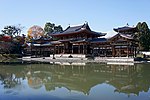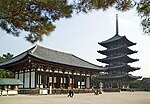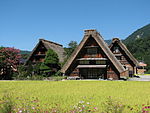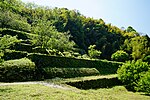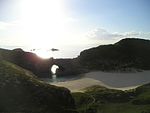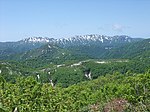List of World Heritage Sites in Japan
The List of World Heritage Sites in Japan is a group of places chosen by UNESCO, the United Nations Educational, Scientific and Cultural Organization.
History[change | change source]
UNESCO was created for the "conservation and protection of the world’s inheritance of books, works of art and monuments of history and science". The constitution of UNESCO was ratified in 1946 by 26 countries.[1]
Japan agreed to take part in the World Heritage Convention on 30 June 1992.[2]
List[change | change source]
The World Heritage Site (WHS)[3] list has developed over time. It is part of a process; and the list continues to grow.
As of 2012, there are 16 WHS places in Japan.[2]
There are 12 sites which are on a tentative list.[2]
Table[change | change source]
Tentative List[change | change source]
The Tentative List consists of sites which have been nominated. The evaluation process is not yet completed.
- Asuka-Fujiwara: Archaeological Sites of Japan's Ancient Capitals and Related Properties[20]
- Churches and Christian Sites in Nagasaki[21]
- Fujisan[22]
- Hikone-Jo (castle)[23]
- Jômon Archaeological Sites in Hokkaidô, Northern Tôhoku, and other regions[24]
- Main Building of the National Museum of Western Art[25]
- Modern Industrial Heritage Sites in Kyûshû and Yamaguchi[26]
- Mozu-Furuichi Kofungun, Ancient Tumulus Clusters[27]
- Okinoshima Island and Related Sites in Munakata Region[28]
- Sado complex of heritage mines, primarily gold mines[29]
- Temples, Shrines and other structures of Ancient Kamakura[30]
- Tomioka Silk Mill and Related Industrial Heritage[31]
In January 2012 the Japanese government requested the inscription of the tentative sites of Kamakura and Mount Fuji in 2013, with plans to request the inscription in 2014 of The Tomioka Silk Mill and Related Industrial Heritage.[32] The Amami and Ryūkyū Islands (Yanbaru) have been selected for nomination as a joint fifth Natural Site and a study panel is to be formed to consider a sixth candidate site.[33]
Related pages[change | change source]
References[change | change source]
- ↑ "UNESCO Constitution"; retrieved 2012-4-18.
- ↑ 2.0 2.1 2.2 2.3 2.4 UNESCO, "Japan"; retrieved 2012-4-18.
- ↑ WHS is an acronym. WHS stands for "World Heritage Site".
- ↑ UNESCO, "Buddhist Monuments in the Hōryū-ji Area"; retrieved 2012-4-18.
- ↑ UNESCO, "Gusuku Sites and Related Properties of the Kingdom of Ryukyu"; retrieved 2012-4-18.
- ↑ UNESCO, "Himeji-jo"; retrieved 2012-4-18.
- ↑ UNESCO, "Hiraizumi – Temples, Gardens and Archaeological Sites Representing the Buddhist Pure Land"; retrieved 2012-4-18.
- ↑ UNESCO, "Hiroshima Peace Memorial (Genbaku Dome)"; retrieved 2012-4-18.
- ↑ UNESCO, "Historic Monuments of Ancient Kyoto (Kyoto, Uji and Otsu Cities)"; retrieved 2012-4-18.
- ↑ UNESCO, "Historic Monuments of Ancient Nara"; retrieved 2012-4-18.
- ↑ UNESCO, "Historic Villages of Shirakawa-go and Gokayama"; retrieved 2012-4-18.
- ↑ UNESCO, "Itsukushima Shinto Shrine"; retrieved 2012-4-18.
- ↑ UNESCO, "Iwami Ginzan Silver Mine and its Cultural Landscape"; retrieved 2012-4-18.
- ↑ UNESCO, Ogasawara Islands; retrieved 2012-4-18.
- ↑ UNESCO, "Sacred Sites and Pilgrimage Routes in the Kii Mountain Range"; retrieved 2012-4-18.
- ↑ UNESCO, "Shrines and Temples of Nikko"; retrieved 2012-4-18.
- ↑ UNESCO, "Shirakami-Sanchi"; retrieved 2012-4-18.
- ↑ UNESCO, "Shiretoko"; retrieved 2012-4-18.
- ↑ UNESCO, "Yakushima"; retrieved 2012-4-18.
- ↑ UNESCO, "Asuka-Fujiwara: Archaeological sites of Japan’s Ancient Capitals and Related Properties"; retrieved 2012-4-19.
- ↑ UNESCO, "Churches and Christian Sites in Nagasaki"; retrieved 2012-4-19.
- ↑ UNESCO, "Fujisan"; retrieved 2012-4-19.
- ↑ UNESCO, "Hikone-Jo (castle)"; retrieved 2012-4-19.
- ↑ UNESCO, "Jômon Archaeological Sites in Hokkaidô, Northern Tôhoku, and other regions"; retrieved 2012-4-19.
- ↑ UNESCO, "Main Building of the National Museum of Western Art"; retrieved 2012-4-19.
- ↑ UNESCO, "The Modern Industrial Heritage Sites in Kyûshû and Yamaguchi"; retrieved 2012-4-19.
- ↑ UNESCO, "Mozu-Furuichi Kofungun, Ancient Tumulus Clusters"; retrieved 2012-4-19.
- ↑ UNESCO, Okinoshima Island and Related Sites in Munakata Region"; retrieved 2012-4-19.
- ↑ UNESCO, "Sado complex of heritage mines, primarily gold mines"; retrieved 2012-4-19.
- ↑ UNESCO, "Temples, Shrines and other structures of Ancient Kamakura"; retrieved 2012-4-19.
- ↑ "Tomioka Silk Mill and Related Industrial Heritage"; retrieved 2012-4-19.
- ↑ "Japan prepares to nominate more sites for registration on global list," Japan Times. 1 January 2012; retrieved 2012-4-18
- ↑ "Govt to select candidate for World Natural Heritage," Daily Yomiuri. 18 February 2012; retrieved 2012-4-18
Other websites[change | change source]
![]() Media related to World Heritage Sites in Japan at Wikimedia Commons
Media related to World Heritage Sites in Japan at Wikimedia Commons
- UNESCO, World Heritage Sites
- GoJapan, World Heritage Sites Archived 2012-01-04 at the Wayback Machine
- Agency for Cultural Affairs, http://www.bunka.go.jp/bsys/index.asp Archived 2005-12-28 at the Wayback Machine; http://www.bunka.go.jp/bunkashingikai/sekaibunkaisan/08/pdf/sankou_1_4.pdf Archived 2012-01-06 at the Wayback Machine
- List of biosphere reserves which are wholly or partially world heritage sites






